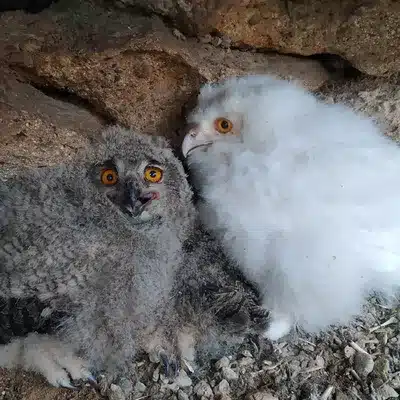Blanquita, the first reported case of incomplete albinism in the Eurasian eagle-owl (Bubo bubo), was spotted within the protected region of Monte El Valle y Sierras de Altaona y Escalona, in southeastern Spain. This is a female owl.
Blanquita's incomplete albinism
Blanquita's coloration is known as “incomplete albinism” because while its feathers are white, it has bright orange eyes. Albinism is the lack of the pigment melanin which often causes white feathers or fur and pink or red eyes.
“The albinism in that case is incomplete because Blanquita had real melanin in the eyes (iris), but also a light black shadow (= attenuated barred) in the wing feathers,” said José Zamora-Marín, co-author of the study.
As she grew, she was given a VHF radio transmitter so that researchers could track her movements as she left the nest. Unfortunately, just 10 weeks later Blanquita was found dead about 20 kilometers west of the nest site.
Her death was likely due to ingesting poisoned rodents which in turn made her more vulnerable to predators. The team wrote that they found “signs of mammal predation” in the area.
“We think that Blanquita may have preyed on rats or other rodents affected by recent rodenticide consumption, thus causing sublethal effects (reduction in basal activity) through secondary exposure and making it vulnerable to predation by a canid (red fox or dog) . In turn, the remains of the wings and body we found showed signs of consumption or predation by canids,” continued Zamora-Marin.

Blanquita's short life gives no indication of what might have happened in her life in terms of reproduction and mate selection, but it highlights the struggle of unusually colored animals to survive and maintain camouflage at resting sites.
Although frequently reported in birds, albinism is only rarely observed in crypticly colored avian species such as owls.
Blanquita's observation occurred in 2020 during a routine field visit to ringed (banded) eagle-owl chicks as part of a long-term monitoring project. Blanquita was the only abnormally colored owl in a brood of four chicks from parents with the typical eagle owl coloration
Albinism in animals
The albinism that characterized Blanquita is the result of cells that are unable to produce melanin, the pigment necessary to color the skin, scales, eyes and hair. This genetic condition is passed on to offspring when both parents carry the recessive gene. When albinism is present, the animal may appear white or pink.
An animal can be completely albino (pure albino) or have leucism. Pure albino animals will have pink eyes, nails, skin and/or scales. The pink coloration comes from blood vessels visible through the skin. Animals affected by leucism may have mostly typical but lighter coloration patterns.
Aside from appearance, these animals often have problems related to albinism, such as vision problems. Melanin helps the development of the eyes, so without it the iris, retina, eye muscles and optic nerves may not form properly. This can cause problems with focusing, depth perception, and tracking in the albino creature.
Because melanin helps protect the skin from sunlight, a lack of pigment means a higher risk of developing melanoma. This causes problems for sunbathing species, often leading to the death of the albino animal.
The birds People with albinism like Blanquita have difficulty finding a partner. While many species attract a potential partner with bright colors, a white bird will likely be rejected.
A bright white animal in a green and brown setting can really stand out. This could cause the creature to be spotted more easily by predators, as happened to Blanquita, due to the disruption of cryptic coloration. Cryptic coloration is the coloration or signs that animals need to blend in with their environment.
Baby deer have their white spots – an example of cryptic coloration – to blend in with the sunspots that shine on the forest floor. However, there have been cases where albino animals have not been recognized as prey due to their strange coloration.
Some amphibians have a different color battle. There have been cases where frogs appeared blue. This is the result of genes that should have caused the frog to become mutant green or brown. The mutation causes different wavelengths of light to be filtered out, resulting in a blue-looking bullfrog.
#Blanquita #1st #case #incomplete #albinism #eagle #owl